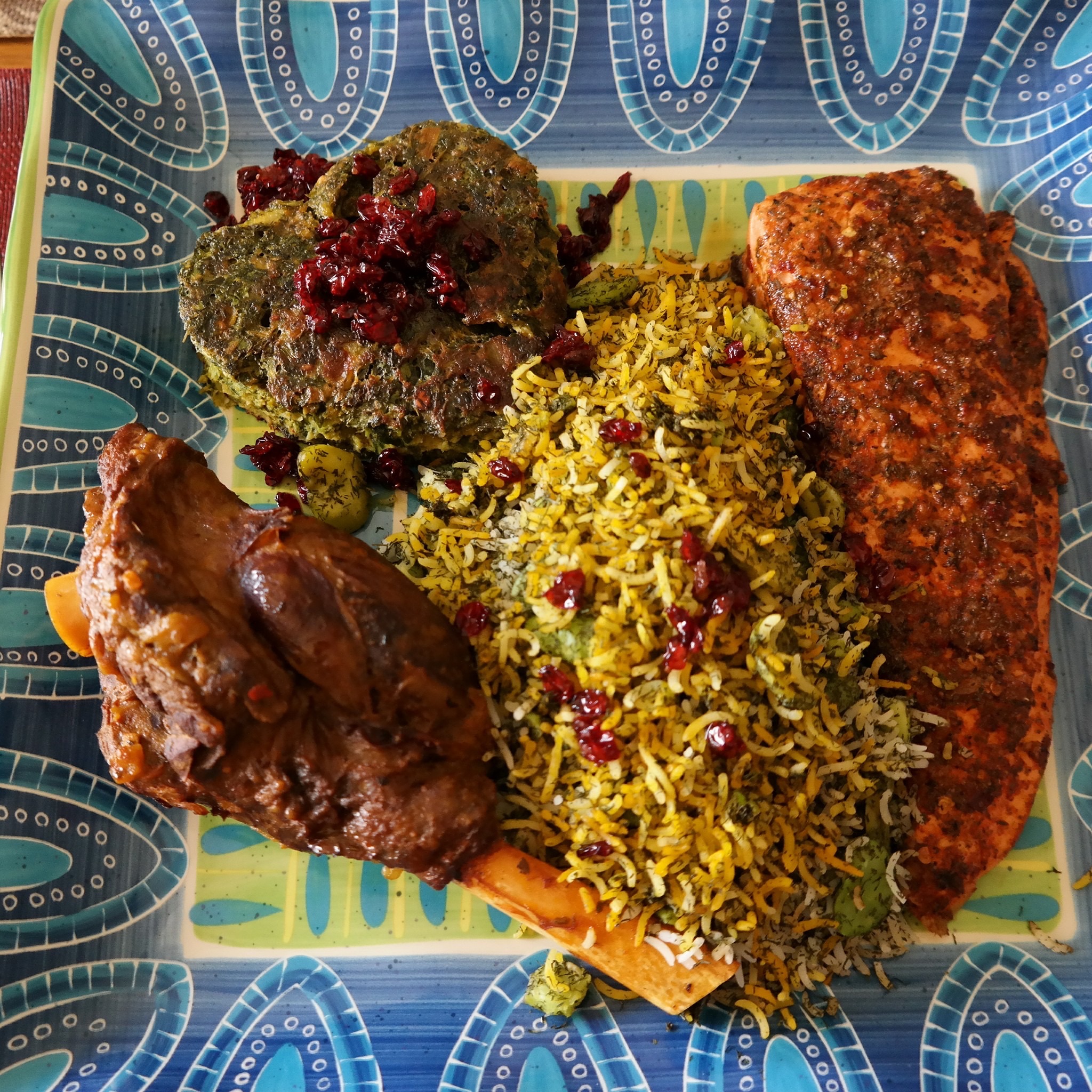
Sabzi Polo ba Mahi means herbed rice with fish. Sabzi is herbs, polo is rice and Mahi is fish. Sabzi polo is a popular Persian mixed rice that is usually made with basmati rice steamed with chopped fresh herbs. The traditional herbs used in this rice are tareh (green nira, also called garlic chives), cilantro, parsley, and dill. It is a tradition to prepare this dish for the Persian New Year or Norouz which is celebrated with the arrival of spring. Sabzi Polo ba Mahi is a New Year favorite in Iran.
Norouz (“New Day”) is the day of the vernal equinox – March 20th this year – and also the first day of the first month of the Iranian calendar (Farvardin). It is a time of great joy and family celebrations that are shared by people of all faiths in many countries that trace their history back through the centuries to the ancient Mesopotamian civilization and the Persian Empire.
Thank you to Shahriar Eskandari from Weaver’s Way Co-op in Philadelphia for sharing this recipe with us!
Ingredients
- For the Sabzi Polo (herbed rice)
- 1/4 tsp ground saffron (bloomed in ½ cup of water)
- 2 ½ cups white long grain basmati rice
- 2 tbsp salt
- 1 cup fresh cilantro
- 1 cup fresh dill
- 1 cup fresh parsley
- 5 scallions
- Olive oil
- 2 tbsp melted butter mixed with 3 crushed or minced cloves of garlic
For the Fish - 4 salmon fillets
- Juice of 1 lemon
- 1 tbsp olive oil
- Small pinch of ground saffron (bloomed in 1 tbsp of water)
- 1 clove garlic (minced or crushed)
- Smoked Sea Salt and Pepper (to taste – you can use normal salt)
Directions
Wash the rice in cold water until the water runs clear. Then place the rice with 1 tbsp of salt in a bowl and pour in cold water to cover up to 2 inches above the rice. Leave to soak overnight.
Marinade the salmon by mixing the olive oil, lemon juice, bloomed saffron, pepper and garlic, and pour it over the fish. Massage the marinade into fillets. Cover and place in the fridge for a minimum of 3 hrs.
Wash all the herbs and scallions. Remove all the tough woody stems from the herbs in batches, through herbs and scallions in a food processor until they are finely chopped. Place the greens in a bowl until you are ready to add to the rice.
Fill a large non-stick saucepan with approximately 6 1/3 cup of water and 1 tbsp of salt. Bring the water to a boil. Drain the rice and then add it to the saucepan. Gently stir the rice to make sure it does not stick to the pan. Every minute gives the rice a gentle stir, take a grain of rice, and check the texture – either between your fingers or using your teeth. What you want is the rice to be soft on the outer layer but still firm in the center. It can take any time from 3 to 7 minutes with the quantity of rice in this recipe.
Once the parboiled rice reaches the correct texture, stir in the chopped greens, turn the heat off and immediately drain the rice in a colander or sieve. Sprinkle a little cold water on the rice to halt the cooking process. Taste the rice – if it is very salty then rinse the rice further with a little water.
Place the empty saucepan on your stove. Add 2 tbsp of oil. Add 1 tbsp of the bloomed saffron to the saucepan and mix with the oil to distribute evenly. To make your rice tahdig spoon about a 1-inch layer of rice into the saucepan and gently stir to mix with the saffron oil to ensure the color is distributed evenly. Be careful not to break the grains. Then pat the rice down flat with a spoon.
Reserve about 5 tbsp of rice and layer the rest into a gentle sloping pyramid shape in the saucepan, drizzling the garlic butter on each layer of rice spooned in. Mix the reserved rice with the remaining saffron water and then spread it on top of the rice in the saucepan. Pour any remaining saffron water over the rice. Poke 5 holes, evenly distributed, into the rice to the bottom of the pan with the end of a spoon.
Place your glass lid on the saucepan and turn the heat to the highest setting. Once you start to see steam rise from the rice (your glass lid will start to get clear from the steam and droplets of water will start to form on the lid – it is perfectly fine to have a little look under the lid now and again to check the steam situation) lower the heat to the minimum flame or equivalent on your cooker. Cover the lid with a tea towel (making sure it is not a fire risk) and replace the lid on the saucepan. Allow to steam for a minimum of 45 mins to get a crunchy and thick layer of tahdig.
Take the salmon out of the fridge to come up to room temperature prior to cooking.
Heat grill to high. Place the fish in a baking dish, then grill for 5 to 7 mins until cooked through, but still a little pink in the center. Add your smoked sea salt (or normal salt if not using) and cover and set aside.
When the rice is cooked, spoon the saffron-colored rice separately in a bowl and reserve for the garnish. Spoon the rest of the Sabzi Polo onto your chosen dish and plate up your tahdig separately. Garnish with the saffron-colored rice and serve with the grilled salmon, fresh naranj (or lemons or limes) to squeeze over the fish and rice.